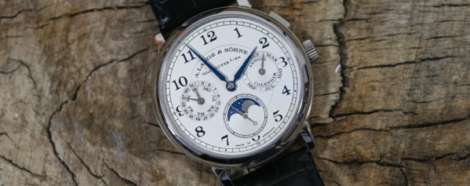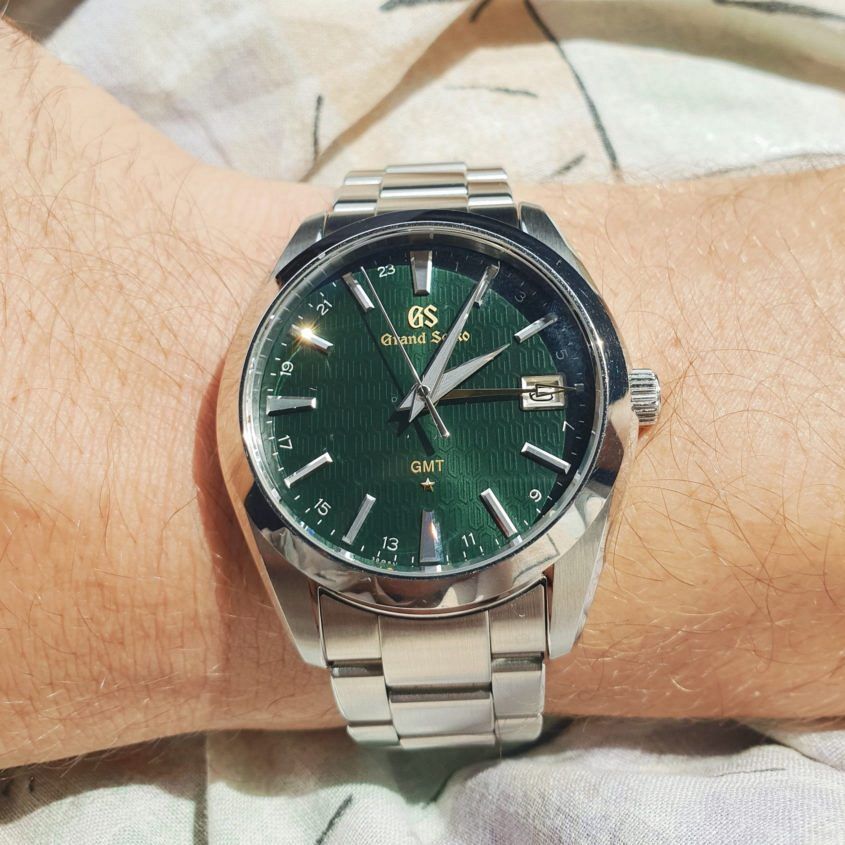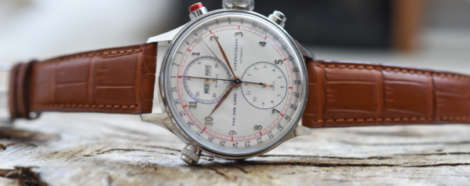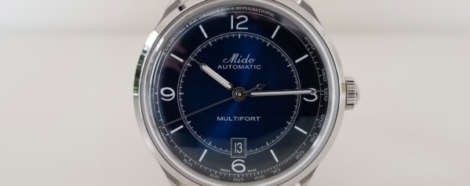IN-DEPTH: The Piaget Altiplano Automatic 40mm with meteorite dial
 The story in a second: Ultra thin and out of this world, we have to be talking about the Piaget Altiplano Automatic 40mm with meteorite dial. Piaget’s Altiplano is a staple in the world of ultra-thin watches, with an elegance that matches its slenderness. This limited edition version dials (if you’ll pardon the pun) the elegance up to 11, with a unique meteorite dial that adds a level of flash and panache that’s hard for a ‘normal’ dial to match. We had the chance to have a closer look at our recent Piaget event, and these are our thoughts … The case This should come as no surprise — this watch is thin. How thin, I hear you all ask, simultaneously? Well, how does 6.5mm sound? I don’t know about you, but it certainly sounds slender to me. This degree of thinness is largely down to the fact that the dial and movement don’t take up much space — more on that later — but the design of the 40mm rose gold case is simple, with straight lines and a broad polished bezel that only goes to accentuate the lack of height. The dial The simple case also serves to accentuate the dial,…
The story in a second: Ultra thin and out of this world, we have to be talking about the Piaget Altiplano Automatic 40mm with meteorite dial. Piaget’s Altiplano is a staple in the world of ultra-thin watches, with an elegance that matches its slenderness. This limited edition version dials (if you’ll pardon the pun) the elegance up to 11, with a unique meteorite dial that adds a level of flash and panache that’s hard for a ‘normal’ dial to match. We had the chance to have a closer look at our recent Piaget event, and these are our thoughts … The case This should come as no surprise — this watch is thin. How thin, I hear you all ask, simultaneously? Well, how does 6.5mm sound? I don’t know about you, but it certainly sounds slender to me. This degree of thinness is largely down to the fact that the dial and movement don’t take up much space — more on that later — but the design of the 40mm rose gold case is simple, with straight lines and a broad polished bezel that only goes to accentuate the lack of height. The dial The simple case also serves to accentuate the dial,…
The post IN-DEPTH: The Piaget Altiplano Automatic 40mm with meteorite dial appeared first on Time and Tide Watches.


 Normally in these hands-on reviews I leave the sticky question of the price until the end. But this time around I’m putting it front and centre. This Montblanc Heritage Automatic has an Australian RRP of $3410. And for that amount of coin, you get a lot of watch. The steel case is well-sized — 40mm across and 11.65mm high, with 20mm lugs packing a really nice grey croc strap with a slight sfumato effect. The lines of this case err, as the heritage name would suggest, towards the more classic in style. Fairly simple construction, a mirror polish, and pleasing, swooping lugs. The movement is a third-party number, reliable, but nothing too exciting, which is why the brand has opted to hide it away behind a nicely engraved picture of the Montblanc, née Minerva, facility in Villeret. It’s worth noting that the caseback is about as close as this watch got to that building, which is strictly the domain of their top-tier pieces — this watch was assembled in the brand’s Le Locle facility. The dial, though, that’s something else. The salmon colour is on-trend for 2019, and very much the right choice for this three-handed heritage offering. Really, though,…
Normally in these hands-on reviews I leave the sticky question of the price until the end. But this time around I’m putting it front and centre. This Montblanc Heritage Automatic has an Australian RRP of $3410. And for that amount of coin, you get a lot of watch. The steel case is well-sized — 40mm across and 11.65mm high, with 20mm lugs packing a really nice grey croc strap with a slight sfumato effect. The lines of this case err, as the heritage name would suggest, towards the more classic in style. Fairly simple construction, a mirror polish, and pleasing, swooping lugs. The movement is a third-party number, reliable, but nothing too exciting, which is why the brand has opted to hide it away behind a nicely engraved picture of the Montblanc, née Minerva, facility in Villeret. It’s worth noting that the caseback is about as close as this watch got to that building, which is strictly the domain of their top-tier pieces — this watch was assembled in the brand’s Le Locle facility. The dial, though, that’s something else. The salmon colour is on-trend for 2019, and very much the right choice for this three-handed heritage offering. Really, though,… Editor’s note: These days, Girard-Perregaux might be best known for their sporty Laureato line, but they have a rich tradition in dressier pieces, which sit in their 1966 collection. This world timer, the Girard-Perregaux 1966 WW.TC, is a case in point — an excellent, dressier take on a complication that traditionally leans to the busier side of life. Read on for the review … Girard-Perregaux is one of Swiss watchmaking’s best-kept secrets. The La Chaux-de-Fonds based brand offers a complete — and compelling — package, fine pedigree, and a catalogue that ranges from the highest of high horology through to some more accessible (yet still exceptional) pieces. But, for whatever reason, GP has long lacked the sort of name recognition they deserve, and which is enjoyed by some of their Helvetican siblings. But it feels like that’s on the cusp of change. Girard-Perregaux is back at the SIHH, with a particularly strong and focused collection. And while the Laureato is their shining star, there are plenty of other worthy offerings in the catalogue. Take, for example, the 1966 WW.TC in steel. The 1966 collection is GP’s clean, classic — and, dare we say it, conservative — collection, and this is the first…
Editor’s note: These days, Girard-Perregaux might be best known for their sporty Laureato line, but they have a rich tradition in dressier pieces, which sit in their 1966 collection. This world timer, the Girard-Perregaux 1966 WW.TC, is a case in point — an excellent, dressier take on a complication that traditionally leans to the busier side of life. Read on for the review … Girard-Perregaux is one of Swiss watchmaking’s best-kept secrets. The La Chaux-de-Fonds based brand offers a complete — and compelling — package, fine pedigree, and a catalogue that ranges from the highest of high horology through to some more accessible (yet still exceptional) pieces. But, for whatever reason, GP has long lacked the sort of name recognition they deserve, and which is enjoyed by some of their Helvetican siblings. But it feels like that’s on the cusp of change. Girard-Perregaux is back at the SIHH, with a particularly strong and focused collection. And while the Laureato is their shining star, there are plenty of other worthy offerings in the catalogue. Take, for example, the 1966 WW.TC in steel. The 1966 collection is GP’s clean, classic — and, dare we say it, conservative — collection, and this is the first… When most watch collectors hear the word quartz they think cheap, mass-produced and soulless. If a watch isn’t mechanical, it isn’t worth talking about, thinking about, and definitely not buying, which are sentiments I broadly agree with. As I wrote here, mechanical watches have a combination of nostalgic charm and independent reliability that I love alongside thousands of watch enthusiasts around the world. So why then did I buy a quartz watch that costs the same as some mechanical Swiss watches? Let me explain why I bought the Grand Seiko SBGN007, and how I feel about the purchase six months later. I’ll start by explaining that when I started collecting watches, I collected vintage Seiko. This is a great way to get started in the hobby, as you don’t have to spend a lot of money to experience a bunch of different watches. For someone starting their collection, this is the perfect scenario. I think starting out this way also stops you from getting any notions that the only good watches are made in a landlocked country in Europe and cost $10,000. It makes you appreciate watches that aren’t necessarily luxury, and how different brands approach watchmaking in a way…
When most watch collectors hear the word quartz they think cheap, mass-produced and soulless. If a watch isn’t mechanical, it isn’t worth talking about, thinking about, and definitely not buying, which are sentiments I broadly agree with. As I wrote here, mechanical watches have a combination of nostalgic charm and independent reliability that I love alongside thousands of watch enthusiasts around the world. So why then did I buy a quartz watch that costs the same as some mechanical Swiss watches? Let me explain why I bought the Grand Seiko SBGN007, and how I feel about the purchase six months later. I’ll start by explaining that when I started collecting watches, I collected vintage Seiko. This is a great way to get started in the hobby, as you don’t have to spend a lot of money to experience a bunch of different watches. For someone starting their collection, this is the perfect scenario. I think starting out this way also stops you from getting any notions that the only good watches are made in a landlocked country in Europe and cost $10,000. It makes you appreciate watches that aren’t necessarily luxury, and how different brands approach watchmaking in a way…


